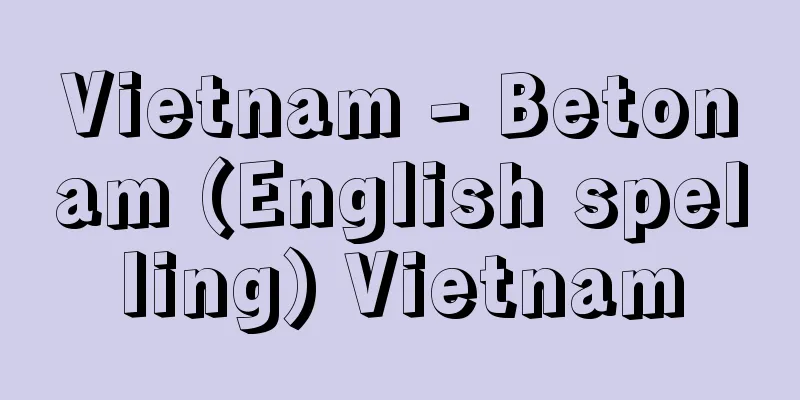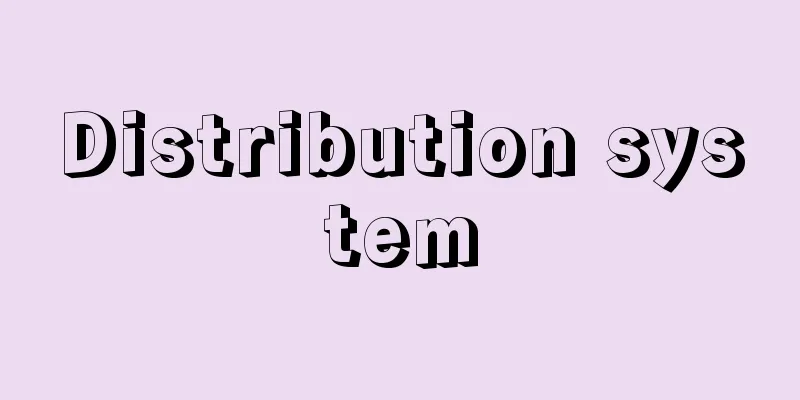Vietnam - Betonam (English spelling) Vietnam

|
A country located in the eastern part of the Indochina Peninsula. Its official name is the Socialist Republic of Vietnam (Công Hòa Xã Hôi Chu Nghîa Viêt Nam), and its Chinese name is Yuen Nan (越南). It was formerly called Trống Son (Annan). In English, it is called the Socialist Republic of Vietnam. It has a long, narrow, S-shaped land area from north to south, bordering China to the north, Laos and Cambodia to the west, and facing the South China Sea. Its area is 331,689 square kilometers. Its population is 87,375,000 (estimated for 2007). Its capital is Hanoi. [Shizuo Maruyama] Nature and ClimateThe country stretches 1,650 km from north to south, and is long and narrow, measuring just 50 km from east to west at its narrowest point (around Dong Hoi). Three-quarters of the country is mountainous. It is made up of Tonkin (Tokyo) in the north, Trống Sơn (Annam) in the center, and Cochinchina (Kochi China) in the south. With the north and south being large and the center being like a corridor, the country's shape is likened to a pole carrying two loads. The north is rich in mineral resources such as coal, iron ore, phosphate ore, chromium, nickel, tin, manganese, bauxite, antimony, and tungsten, while the south is rich in agricultural products such as rice and rubber. The country was established by connecting the north and south with the corridor in the center. Vietnam's nature and climate are primarily shaped by the monsoon, the Trong Son Mountain Range (also known as the Annamite Mountain Range, and called the Phu Luong Mountain Range in Laos), and two major rivers (the Song Khoi River and the Mekong River). The Trong Son Mountain Range acts as the backbone of the country, and the two major rivers, the Song Khoi River and the Mekong River, have created huge deltas in the north and south. The Tonkin Delta in the north has a delta area of 16,000 square kilometers, and the Mekong Delta in the south has a delta area of 44,000 square kilometers, of which 8,000 square kilometers are in Cambodia and 36,000 square kilometers are in Vietnam. The two deltas create fertile grain-producing areas, and the monsoons bring large amounts of rain that shape Vietnam's climate. The Trống Son mountain range is located at the southeastern edge of the Himalayan orogenic belt. The range is high in the northwest and gets lower as you move southeast. The highest peak is Mt. Fansipan, which is 3,143 meters high and the highest in the Indochina Peninsula. The total length of the range is 2,580 kilometers. There is a road (National Highway 1) and a railway (between Hanoi and Ho Chi Minh) that run north and south along the range, but the only national highway that crosses the range is National Highway 9, which connects Savannakhet in Laos and Quang Tri in Vietnam. This is the narrowest part of the country. In addition to National Highway 9, there are passes that are naturally formed in the lower part of the range to travel between east and west, such as the Bar Selemy Pass, Keo Nua Pass, Mu Gia Pass, and Ay Lao Pass. During the Vietnam War, the Ho Chi Minh Trail, which served as a transportation route for personnel, weapons, ammunition, equipment, materials, and other supplies from north to south, threaded its way south through these mountain passes and cutting through the mountains. The northern and northeastern parts of Tonkin are border areas with China, and the border is 1,150 kilometers long. This area is called Viet Bac. The mountains are made of limestone, and many caves have been eroded by rain. The indigenous people probably lived in these caves. The Vietnamese national independence struggle led by Ho Chi Minh also made skillful use of these caves. Between Tonkin and China, the Yuan-Vietnam Railway runs from Haiphong to Kunming, and the Nanning Railway runs from Hanoi to Nanning. The former has Lao Cai as its border station on the Vietnamese side, and Pingxiang as its border station on the Chinese side. The southern end of the Trong Son mountain range is Thai Nguyen (Thai means west, Nguyen means plateau, therefore it means Western Plateau). It is a vast plateau stretching 450 km north to south and 150 km east to west, stretching from Ngoc Linh Mountain (2,598m), the highest peak in the central region, to the south through the Kon Tum Plateau, Dar Lak Plateau, and Dalat Plateau. The plateau is made of basalt rock, high in altitude, and densely forested, with rapids and swamps between them, making it a natural fortress. It has been said since ancient times that "he who controls the Western Plateau controls Vietnam," and during the general attack on Saigon (Ho Chi Minh Operation) in the spring of 1975, the Vietnamese army first established a foothold here to start the battle, and then captured Saigon (now Ho Chi Minh City) in one fell swoop. Thai Nguyen is rich in elephants, wild cattle, deer, tigers, leopards, mountain pigs, and peacocks (especially famous as a habitat for tigers and wild elephants), and was a hunting ground in Asia during the French colonial period, and famous hunters from around the world gathered there to hunt tigers. However, many of these animals were sacrificed in battle during the Vietnam War. The Song Khoi River originates in Yunnan Province, China, and empties into the Gulf of Tonkin at Hai Phong. It is 1,140 km long, 640 km of which flow through China and 500 km through Vietnam. In addition to the Song Khoi River, it has many other names, including Yuan Chan (Chinese name), Flor Lu Di, and Song Hong Ha. Son means river, and Khoi, Lu Di, and Hong Ha mean red, so it means red river. The river's water contains a large amount of iron, giving it a red color, which is why it was given these names. The volume of water in the Song Khoi River during the rainy season is 40 times higher than when it is low in the dry season. The river water carries 130 million tons of soft mud every year, which accumulates on the riverbed and causes floods. Residents build embankments to prevent flooding. The embankments are 4,570 km long. The life of the delta residents is also a battle against water. The Mekong River originates in Tibet, flows through China, Myanmar (Burma), Laos, Thailand, and Cambodia, enters southern Vietnam, and empties into the East Sea (South China Sea) at nine mouths. It is an international river with a total length of 4,425 km. "Me" in Mekong means "mother" and "Kong" means "great river", so the Mekong means "mother river". In China, it is called the Lancang River, in Cambodia the Mekong River, and in Vietnam the Cuu Long River (named after the nine mouths of the river). Since France colonized the country, they gathered workers from all over Cochinchina and developed it into a grain-producing region. As a result, there were many plantations run by feudal landlords and French people, which later became the base of the Liberation Front's activities. There are many international development plans in the lower Mekong basin, and there are abundant offshore oil fields off the estuary, and this crude oil is Vietnam's main export. Vietnam is in the tropical monsoon climate zone, with high temperatures and heavy rainfall, with the average annual temperature being 25.9°C in Da Nang and 27.2°C in Ho Chi Minh, and the average annual humidity being high at around 80% in all areas. The annual precipitation exceeds 1,500 mm in all areas. The year is divided into a dry season and a rainy season, with the dry season running from November to April and the rainy season running from May to October. The country is rich in vegetation, with 7,000 species of plants (289 families), of which 1,000 are medicinal plants. There are said to be 1,000 species of birds and insects, 300 species of mammals, and 1,000 species of fish. [Shizuo Maruyama] History and Ethnic GroupsVietnam has a long history, with people inhabiting it in the prehistoric period (Stone Age), and in the historic period (Metal Age), they cultivated rice fields and had the technology to cast household and decorative items. At that time, the Kinh (Kinh means capital) people lived in the coastal plains of southern China. They had various customs, habits, and organizations, and were also called the Baiyue. The southernmost of these was the Luo Yue, who are said to be the ancestors of Vietnam. Pushed by the expansion and development of the Han people, the Luo Yue gradually moved south, and around the 3rd century BC, they settled in the lower reaches of the Song Khoi River and created the Van Lang (Wen Lang) Kingdom. They mixed with the indigenous Australoid Negrito people, absorbed their Neolithic culture, and also actively accepted Chinese culture, forming their own agricultural culture (Bronze Age culture). This is called the Dong Son culture. The Van Lang Kingdom maintained a royal lineage of 18 generations, but was later replaced by the Au Lac Kingdom (甌经, 甌雒). The Au Lac Kingdom established its capital in Coloa (near Hanoi) and controlled the Song Khoi Delta and the coastal plains to the south. The Au Lac Kingdom had administrative, judicial and military organizations and is considered to have been a primitive state. However, in 111 BC, the Kingdom was conquered by Emperor Wu of the Western Han Dynasty and became his colony, and the Đōng Sơn culture declined with it. The exact time of the decline of the Đōng Sơn culture is said to be 41 AD, when General Ma Yuan, dispatched by Emperor Guangwu of the Eastern Han Dynasty, defeated the anti-Han revolt of the sisters Trung Trac (Trịch's side) and Trung Nhi (Trịch's side). From this point on, the history of Vietnam became a history of Chinese domination and resistance to it. China's colonial administration employed soldiers and officials (the military and bureaucracy) as the vanguard, and implemented a thorough assimilation policy that included the introduction of Chinese characters and classical Chinese literature, Confucianism, the imperial examination system, and administrative and judicial systems. In the course of the anti-Chinese struggle, Vietnam took on a village community-like structure, and with the increase in productivity due to iron tools, the expansion of developed areas, and the reorganization of communities due to class differentiation, the desire to become an independent sovereign state gradually strengthened. Thus, Li Bon defeated the armies of the Chinese Liang Dynasty and Champa, and founded the Wanchun Kingdom in 544. Champa was founded on the east coast of central Vietnam in 192 AD, and was a kingdom strongly influenced by Indian culture. Dynasties that sought independence from Chinese rule continued after that, including the Ngo Dynasty (939), the Çinh Dynasty (966), the Pre-Lê Dynasty (980), and the Ly Dynasty (1009). The period when Vietnam was under Chinese rule is called the "Period of Northern Subjects" in Vietnam, and is generally considered to be the 1,050 years from 111 BC to the establishment of the Wu Dynasty in 939. After the Ly dynasty (1009-1225), the Trinh dynasty (1225-1400), the Le dynasty (1428-1527, 1533-1789), and the Nguyen dynasty (1802-1945) were established. The country was called Dai Viet during the Ly, Trinh, and Le dynasties, and Vietnam Southern during the Nguyen dynasty. During this period, the Trinh dynasty saw three attacks by Mongolian troops (Yuan) (1257, 1284-1285, 1287-1288), which the Trinh dynasty repelled. The Le dynasty was defeated by the Tay Son rebellion (1771, a peasant uprising), and the Nguyen dynasty ruled Vietnam for about 30 years. In 1802, Nguyen Phuoc Anh established the Nguyen Dynasty after defeating the Xuan Phuoc Party. Nguyen Phuoc Anh called himself Emperor Gia Long and moved the capital from Hanoi to Hue. The Nguyen Dynasty lasted in name only from the first Emperor Gia Long (1806-1820) to the thirteenth Emperor Bao Dai (1925-1945), but when Nguyen Phuoc Anh asked for French aid in his fight against the Xuan Phuoc Party, he invited French colonialism, and Vietnam became a complete French colony in 1884, and the Nguyen Dynasty lost its independence. Vietnam's ethnic governments lasted for 945 years, from the Ou Dynasty to the Nguyen Dynasty. During France's rule over Vietnam, they attempted to romanize Vietnamese (which later became the national language of Vietnam), provided various cultural resources, and contributed to the progress and development of Vietnam, but at the same time, their colonial rule through oppression and exploitation was extremely harsh. As a result, a wide range of resistance movements were organized. These included the peasant movement, which was centered on the peasants, the literati movement (loyalist movement) by lower-ranking bureaucrats, local intellectuals, and some landowners, the national restoration movement led by Phan Boi Chau (Pan Pei Zhu) (the movement to support Cuong De Hou, a direct descendant of Prince Jing, the fourth generation descendant of Emperor Seizu of the Nguyen Dynasty), the Nationalist movement led by the Nguyen University and others, and the revolutionary struggle of the Vietnamese Communist Party led by Ho Chi Minh (Nguyen Patong). As soon as the Japanese army invaded northern French Indochina in September 1940 and southern French Indochina in July 1941, the Communist Party of Vietnam pushed the national united front, the Viet Minh (League for the Independence of Vietnam, formed in May 1941), to the forefront and launched parallel anti-French and anti-Japanese struggles. Vietnam won independence and liberation through the "August Revolution" (general uprising in August 1945), and the Democratic Republic of Vietnam was established on September 2, 1945. After World War II, France returned to Indochina with the intention of recolonizing the country, and Vietnam fought against them for eight years (Indochina War, December 1946 to July 1954). After Vietnam repelled France, the United States took their place. In 1955, the United States established the Republic of Vietnam in the south with Ngo Dinh Diem as president, while at the same time neutralizing the north of Vietnam with air power, and attempted to decommunize (Americanize) the whole of Vietnam. This was the Cold War strategy of containing communism, the Vietnam War. Vietnam suffered such damage in this war that the whole country was reduced to ashes, but did not give in, and on April 30, 1975, they captured Saigon (overthrew the Republic of Vietnam) and drove out the American troops. The harsh natural environment, the constant oppression, exploitation and discrimination by the ruling powers within the country, and the forced division, division, and imposition of different cultures by successive foreign powers, tempered the people and raised them to be a tough people. Learning from history, Vietnam wrote a new history for itself. [Shizuo Maruyama] Politics and EconomyHo Chi Minh, who fought for Vietnam's national independence and socialist revolution and became president and head of state, passed away on September 3, 1969, at the age of 79, without seeing the victory of the Vietnam War. After his death, political, military and party affairs were left to the first generation of revolutionaries who had walked the path of revolution and struggle with Ho Chi Minh. The first generation of revolutionaries were Phan Van Dong (Prime Minister), Truong Chinh (General Secretary of the Communist Party, Deputy Prime Minister, Chairman of the Standing Committee of the National Assembly, Chairman of the State Council), Vo Nguyen Giap (Commander-in-Chief of the People's Army, Deputy Prime Minister, Minister of Defense), Le Duan (Secretary-General of the Worker's Party), and Le Duc Tho (Central Committee member of the Worker's Party, delegate to the Paris Conference). Eventually, this first generation quietly retired from the front line, and the responsibility for national affairs was gradually transferred to the second generation. The second generation includes Nguyen Van Linh (General Secretary), Do Muoi (General Secretary), and Vo Van Kiet (Prime Minister, 1922-2008). There is not a big gap between the first and second generations, and the time of the transfer of responsibility cannot be clearly defined. However, there are some differences in age and career, as well as in their ideas and attitudes toward problems, and there are differences that make it clear that they are from different generations. The era of Ho Chi Minh was a time of struggle for national independence and unity, and for socialist revolution. Ho Chi Minh was a great man, but the great cause of the nation that he entrusted to us was not accomplished, and he passed away halfway through. The first and second generations were entrusted with the completion of the great cause, and they were truly transitional generations. The transitional generation was burdened with three tasks. The first was to complete the Vietnam War and reunify Vietnam and achieve the socialist revolution. The second was to end the Cambodian conflict and the Sino-Vietnamese War and establish security. The third was economic reform. The Vietnam War ended with a complete victory with Operation Ho Chi Minh (March 10 to April 30, 1975), which was launched from the Western Highlands. With this, the reunification of Vietnam was also achieved. In the Cambodian conflict, Vietnam sent in a large army to drive the Pol Pot faction out of the border area (the Pol Pot regime collapsed in January 1979), and brought the fighting to an end by supporting the anti-Pol Pot, pro-Vietnamese Heng Samrin regime. Vietnamese troops began to withdraw from Cambodia in July 1982, and by September 1989, all troops had been withdrawn. During the Sino-Vietnamese War, Vietnam prepared by building three lines of defense from the mountainous region of the border to the plains. However, the first line of defense was able to prevent most Chinese troops from invading. On March 19, 1979, Vietnam announced that the battle had been won, and the Chinese side said that they would withdraw voluntarily, as sanctions had been lifted. In order to deal with these transitional issues, Vietnam enacted the 1980 Constitution (adopted by the 6th National Assembly in December 1980). This replaced the previous presidential (head of state) system and established the Council of State as the highest state organ. The Council of State had great powers. Truong Chinh was elected chairman in July 1981. The 1980 Constitution was heavily state-led and socialist in the Soviet and Eastern European style. It was an attempt to fill the gap left by the death of Ho Chi Minh through the leadership of a strong state and party. However, opposition to this constitution grew (Truong Chinh died in 1988), and discussions on amendments began at the National Assembly in July 1991. The revised Constitution, the 1992 Constitution, was adopted at an extraordinary National Assembly session in April 1992. The 1992 Constitution abolished the Council of State and restored the normal presidential (head of state) system. Le Duc Anh (1920- ) was elected president, marking a generational change in leadership. The parliament based on the 1992 Constitution is a unicameral National Assembly. The political party is the Communist Party of Vietnam. Other supporting forces include the Vietnam Fatherland Front. In 1997, Tran Duc Luong became president. The constitution was amended again in December 2001, expanding the powers of the National Assembly and establishing laws in line with the economic reform policies introduced in 1986 and the progress of the Doi Moi policy. In 2006, Tran Duc Luong retired, and Nguyen Minh Triet (1942- ) was elected president at the National Assembly held in the same year. Vietnam's foreign policy had previously focused on the former Soviet Union and Eastern Europe, but later switched to an all-round diplomacy, with particular emphasis on Asian diplomacy. Vietnam joined the United Nations in 1977, and ASEAN (Association of Southeast Asian Nations) in 1995, normalizing relations with the United States in the same year. The focus of its Asian diplomacy is likely to be on diplomacy with China. Relations between the two countries had deteriorated due to the mass exodus of Chinese (January-August 1978), China's support for Cambodia in the Cambodian conflict, and the Sino-Vietnamese War, but talks on normalizing diplomatic relations in line with the Five Principles of Peaceful Interaction progressed, and in November 1991, the two countries declared the normalization of diplomatic relations. In February 1996, two Sino-Vietnamese railway lines were reopened, between Dong Dang and Nanning, and between Lao Cai and Kunming. Vietnam, experiencing an economic downturn after unification, realized that it would be difficult to rebuild its economy with the previous centralized and bureaucratic economic management system, and decided on an economic reconstruction plan and an open-door policy at the 6th Party Congress in December 1986. This was the Doi Moi policy. The specific contents of the policy included allowing farmers to run their own businesses, introducing a contract system for products (allowing free disposal of surplus products), allowing companies to produce consumer goods using raw materials other than those controlled by the state, distributing them freely and distributing the income gained from them to employees, allowing companies to engage in service industries such as repairs and tailoring, revising the average-based wage system of companies and introducing a piecework system and bonus system, and classifying state-owned enterprises according to their importance, giving priority to supplying materials to key enterprises, while allowing other companies to freely dispose of their products in exchange for procuring the materials they needed for production themselves. This new policy generated new opposition and confusion, but was revised each time. The 1992 Constitution proclaimed the adherence to socialism and confirmed the continuation of the Doi Moi economic reform policy, which was the core of the transitional system. A more flexible, rational, and liberal approach was chosen, which could also be considered Vietnamese-style socialism. The biggest challenge going forward will be how to establish socialism within Doi Moi and how to link socialism with Doi Moi. The economy has recovered to the point where it has a gross domestic product (GDP) of $71.6 billion ($818 per capita in 2007), and food production is 39.65 million tons of grains alone (2006), of which rice production was 35.83 million tons (2006), making it the world's second largest exporter after Thailand. The country's economic growth rate stagnated due to the Asian currency crisis in 1997 and 1998, but has remained at a high level of 7-8% since 2003. In 2007, the country officially joined the World Trade Organization (WTO). [Shizuo Maruyama] Society and CultureVietnam is a multi-ethnic country with over 50 different ethnic groups. The distribution of the ethnic groups is as follows: the Kinh, the main ethnic group, lives in the Song Khoi Delta, the central coastal plain, and the Mekong Delta; the Viet Bac and Tai Bac regions in the north have Sino-Tibetan and Australoid minorities (Tai, Nung, Muong, Yao, Meo, etc.); the Mon-Khmer and Malayan-Polynesian minorities (Khmer, Cham, Moi, etc.) in the central and southern regions; and urban minorities (Chinese) in the southern delta region. The Kinh make up 86% of the total population, and the minorities make up 14%. In societies such as the Yao and Meo, Chinese characters and classical Chinese are still used for funeral ceremonies, and Vietnam can be considered to be part of the Chinese character culture sphere along with China, Taiwan, Korea, and Japan. Three-quarters of the minorities live in the northern mountainous region, and one-quarter live in the mountainous and plain areas of the central and southern regions. Vietnam is a country with many minorities. Many of the major ethnic groups and minorities came south from mainland China, and Chinese culture took root in Vietnam after a long period of Chinese rule. However, Chinese culture was concentrated in Vietnam, while Indian culture (especially Theravada Buddhism, or Hinayana Buddhism) took root in the west of the Trong Son mountain range. Theravada Buddhism advanced eastward through Ceylon (Sri Lanka) and Burma (Myanmar), and reached Thailand, Laos, and Cambodia, but could not enter Vietnam. Meanwhile, Chinese culture remained in Vietnam and could not advance westward beyond the Trong Son mountain range. The Trong Son mountain range was a natural watershed that separated Laos, Cambodia, and Vietnam, but at the same time, it seems to have been a cultural watershed. The movement and establishment of cultures is not something that can be divided so simply or clearly, but is accompanied by mixing. In fact, Champa in central Vietnam was a country that flourished with Indian culture. However, Champa was later destroyed by Vietnam. In the end, it can be said that Indian culture was unable to establish itself beyond the mountain range. Although Chinese culture has penetrated to the west of the mountain range and Indian culture to the east, these remain the domain of the minority, with the majority of people living in the Chinese cultural sphere in the east and the Indian cultural sphere in the west. Under the influence of Chinese culture, education spread in Vietnam and culture was improved, but this also strengthened the country's subordination to China (Chinese characters were introduced between the 1st and 2nd centuries BC). Concerned about this, Vietnam created the national script Chu Nom in the 13th and 14th centuries, mainly during the Tran Dynasty. This was also a kind of modified Chinese characters. This led to a literary boom and many masterpieces such as "Kinbankyo" were published, but the method of creating the characters was complicated and it was rather inefficient as a means of transmitting information. For this reason, although it spread among the upper classes, it did not spread much among the general public. France, which colonized Vietnam, came up with a Romanization system for Vietnamese in order to improve the efficiency of information transmission. This was the romanization of Vietnamese devised by French missionary Alessandro (Alexander) Lode in the 17th century. This replaced Chu Nom, was widely supported by the people, and became the national language (Quoc Ngu) after Vietnam's independence. The French colonial rule was characterized by an emphasis on cities, assimilation policy, and divide and rule. This meant emphasizing cities over rural areas as the object of rule, fixing Vietnam as a source of raw materials over developing ethnic industries, assimilation into French culture over the development of traditional culture, and division (divide and rule) over unification. Thus, Vietnam was divided into three regions: Tonkin (protectorate), Trốn Son (protectorate), and Cochinchina (direct colony), each of which developed a slightly different culture and society. While China viewed Vietnam as one entity and in return adopted a thorough policy of sinicization, France adopted a policy of division. The saying "the emperor's rule stops at the village fence" was also evidence that French rule was centered on cities. Eventually, Ho Chi Minh challenged French rule with a fight for national liberation and socialist revolution. In 1940, Japan appeared and its military rule developed in a way that overlapped with French colonial rule, and Vietnam unified its anti-French and anti-Japanese struggles to fight against it. Then, when France tried to return with the aim of recolonizing Vietnam, Vietnam repelled them with a "People's War" strategy. Then, the United States invaded Vietnam using neo-colonial methods. Foreign rulers, whether they were Chinese, French, Japanese, or American, forced their own cultures on Vietnam, including language, religion, customs, lifestyles, and education, administration, and judicial systems. Vietnam's struggles were truly a series of battles among different cultures. [Shizuo Maruyama] Relations with JapanJapan and Vietnam have had a long relationship, and Abe no Nakamaro was the first to appear on the historical stage of Vietnam. Nakamaro was appointed Protector of Chinnam by Emperor Suzong during the Tang Dynasty in China, and was stationed in Vietnam from 760 to 761. In 766, he was appointed Protector of Annam by Emperor Daizong, and was stationed in Vietnam again. The Protector of Chinnam, Protector of Annam, or Governor of Annam was tasked with pacifying and governing Annam (Vietnam), and was essentially a governor. The area under his jurisdiction stretched from the area bordering Guangdong and Guangxi in the north to the area near Deo Anam (Annam Pass) on the 18th parallel north in the south. The Protectorate was said to be located either in Hanoi or near Vinh. The famous poem from the Kokin Wakashu, "Looking back across the plains of the heavens, I see the moon rising over Mount Mikasa in Kasuga," is said to have been written by Nakamaro at this time, overcome by longing for home. During the Muromachi period, red seal ships went to Tonkin and engaged in red seal ship trade, and in the Azuchi-Momoyama period and early Edo period, Japanese towns were established in Tu Lan (Da Nang) and Fai Pho (Hoi An), where a kind of self-governance was permitted. The northeast monsoon blows through the South China Sea and the Gulf of Tonkin and onto the central coast of Vietnam. Ships wrecked by the monsoon would drift here, and some would marry locals and settle down, unable to return home. Perhaps this is where the legend of Urashima Taro originated. However, after the Tokugawa Shogunate issued an order to close the country in 1639 (Kan'ei 16), overseas travel came to a halt. It was not until the Meiji period that Japanese people would appear in Vietnam again, with the "Karayuki-san" and "Joushi-gun" being the pioneers. になったんです。 English: The first thing you can do is to find the best one to do. になったんです。 English: The first thing you can do is to find the best one to do. になったんです。 English: The first thing you can do is to find the best one to do. In August 1945, the Japanese surrendered, and the southern forces reached the "end of the war" in Darat, a suburb of Saigon. になったんです。 English: The first thing you can do is to find the best one to do. On the other hand, in September 1973, Japan established diplomatic relations with the Democratic Republic of Vietnam (later the Socialist Republic of Vietnam; North Vietnam). Vietnam invaded Cambodia in December 1978, claiming that it had been attacked by Cambodia. As a result, Western countries halted economic aid to North Vietnam as "economic sanctions," and Japan followed suit. The suspension lasted for 14 years, but as soon as the peace agreement between Vietnam and Cambodia was reached, Japan resumed official development assistance (ODA) to Vietnam in November 1992 and provided yen loans. Japan is second in Vietnam's trading partner after China, and Japan's investment amount is fourth on the basis of approval, after South Korea, Singapore, and Taiwan, and first on the implementation basis. [Shizuo Maruyama] "Vietnam: Nature, History, Culture, Politics and Economy" (1977-1978, Wednesdaysha)" (1977-1978, Wednesdaysha) " (1981, Kodansha)" (1981, Kodansha)" (Shigeo Maruyama Shizuo) " (Kodansha)" (1993, University of Tokyo Press)" (1993, University of Tokyo Press)" (Kagaya Kozo Kagawa, Labor, Law, and Culture in Vietnam (2006, Shinzansha Publishing)" (2006, Publishing)" (1906, Publishing)" (1908, Publishing)" (1908, Publishing)" (1908, Publishing)" (1908, Publishing)" (1908, Publishing)" (1908, Publishing)" (1908, Publishing) " (1908, Publishing)" (1908, Publishing)" (1908, Publishing)" (1908, Publishing)" (Matsuo Masako, "The Politics of Ethnicity: History and Present of Vietnam's Classification of Ethnicity" (2008, Sangensha)" [Reference items] | | | | | | | | -Hun Moi | | | | | | | | | | | Minh | | | | | [Complete Materials] |"> Vietnam flag ©Shogakukan Illustration/Shogakukan Creative "> Vietnam location map Former Saigon City Hall. It is one of the buildings during the French rule period. Vietnam Ho Chi Minh ©Masashi Tanaka "> Ho Chi Minh People's Committee Office The former Presidential Palace of the Republic of South Vietnam. It is a symbolic structure of Vietnam's unification. Vietnam Ho Chi Minh ©Masashi Tanaka "> Unification Hall It was built as an opera house during the French rule period. It is used for concerts and theater performances. Vietnam Ho Chi Minh ©Masashi Tanaka "> Civic Theatre Source: Shogakukan Encyclopedia Nipponica About Encyclopedia Nipponica Information | Legend |
|
インドシナ半島東部に位置する国。正称はベトナム社会主義共和国Công Hòa Xã Hôi Chu Nghîa Viêt Nam、漢名は越南(えつなん)。かつてはチョンソン(安南)ともよばれた。英語ではSocialist Republic of Vietnam。南北に細長いS字形の国土を有し、北は中国、西はラオス、カンボジアに接し、南シナ海に面する。面積33万1689平方キロメートル。人口8737万5000(2007推計)。首都はハノイ。 [丸山静雄] 自然・風土国土は南北1650キロメートル、東西は狭い所(ドンホイのあたり)で50キロメートルと細長い。国土の4分の3は山地が占める。北部のトンキン(東京)、中部のチョンソン(安南)、南部のコーチシナ(交趾支那(こうちしな))からなる。北部と南部が大きく、中部が回廊のようになっているところから、国の形は天秤棒(てんびんぼう)で二つの荷物を担いだ姿に例えられる。北部は石炭、鉄鉱石、燐(りん)鉱石、クロム、ニッケル、錫(すず)、マンガン、ボーキサイト、アンチモン、タングステンなどの鉱物資源に富み、南部は米、ゴムなどの農産物に富む。北部・南部の両者を中部の回廊地帯が結び付けることによって国は成り立った。 ベトナムの自然と風土は、主としてモンスーンとチョンソン(長山)山脈(アンナン山脈ともいい、ラオスではフールオン山脈という)と二大河川(ソン・コイ川、メコン川)によって形成される。チョンソン山脈は脊梁(せきりょう)となって国土を組み立て、ソン・コイ川、メコン川の二大河川は北と南に巨大なデルタを生んだ。北のトンキン・デルタはデルタ面積1万6000平方キロメートル、南のメコン・デルタはデルタ面積4万4000平方キロメートルで、うちカンボジア領内のデルタは8000平方キロメートル、ベトナム領内のデルタは3万6000平方キロメートルである。二つのデルタは豊饒(ほうじょう)な穀倉地帯を造出し、さらにモンスーンが大量の雨を運んでベトナムの風土を形づくる。 チョンソン山脈は、ヒマラヤ造山帯の東南端に位置する山系である。山系は北西部で高く、南東に進むにつれて低くなる。最高峰はファンシーパン山で、高さ3143メートル、インドシナ半島でもっとも高い。山系の全長は2580キロメートルと長い。山系沿いには南北に通ずる道路(国道1号線)と鉄道(ハノイ―ホー・チ・ミン間)があるが、山系を横断する国道は、ラオスのサバナケットとベトナムのクアンチを結ぶ9号線だけである。このあたりは国土がもっとも狭い。9号線のほか、東西の往来には山系の低部に自然につくられた、バーセレミイ峠、ケオ・ヌア峠、ムジア峠、アイラオ峠などの峠道がある。ベトナム戦争の際に、北から南への人員、兵器、弾薬、装備、資材、その他物資の輸送路となったホー・チ・ミン・ルートは、こうした峠を縫い、山系を切り開いて一路南下したものである。 トンキン地区の北部・東北部は中国との国境地帯で、国境線の長さは1150キロメートル。ここは「ベトバク」とよばれる。山地は石灰岩からなり、雨に侵食されて洞窟(どうくつ)が多い。おそらく先住民族は、こうした洞窟に住みついていたのであろう。ホー・チ・ミンが主導したベトナム民族独立闘争も、この洞窟を巧みに利用して展開された。中国との間には、ハイフォン―昆明(こんめい/クンミン)間に滇越(てんえつ)鉄道が、またハノイ―南寧(なんねい/ナンニン)間に南寧鉄道が通じ、前者のベトナム側国境駅はラオカイ、後者の中国側国境駅は凭祥(ピンシャン)となっている。 チョンソン山系の南端はタイグエン(タイは西、グエンは高原、したがって西部高原の意味)で、中部地区の最高峰ゴクリン山(2598メートル)から南にコントゥム高原、ダルラク高原、ダラト高原を連ね、南北450キロメートル、東西150キロメートルにわたる広大な台地である。台地は玄武(げんぶ)岩質からなり、標高は高く、森林は濃密で、その間に急流、沼地があり、自然の要害をなす。古来、「西部高原を制するものはベトナムを制す」といわれ、1975年春のサイゴン総攻撃(ホー・チ・ミン作戦)の際も、ベトナム軍はまずここに足場を築いて戦いのスタートを切り、一挙にサイゴン(現、ホー・チ・ミン市)を攻略した。 タイグエンにはゾウ、野牛、シカ、トラ、ヒョウ、山ブタ、クジャクが多く(とくにトラや野象の生息地帯として有名)、フランス植民地時代にはアジアの狩場とされ、トラ狩りには世界の名ハンターが集まった。しかしその動物たちの多くはベトナム戦争で、戦いの犠牲にされたという。 ソン・コイ川は中国の雲南省に源を発し、ハイフォンでトンキン湾に注ぐ。全長1140キロメートル、そのうち640キロメートルが中国内を、500キロメートルがベトナム内を流れる。名称はソン・コイ川のほかにも、ユアンチャン(中国名)、フロールージ、ソンホンハなど多くの別名をもつ。ソンは河(川)を、コイ、ルージ、ホンハは赤を意味し、赤い河(川)ということになる。この川水が鉄分を大量に含んで赤色を呈しているため、こうした名でよばれるようになった。ソン・コイ川の雨期後の増水時の水量は、乾期の減水時の40倍にも増える。川水は軟らかい泥土を年間1億3000万トンも運び、泥土は川床に堆積(たいせき)し、洪水を招く。住民は堤防を積み上げて洪水を防ぐ。堤防の延長は4570キロメートル。デルタ住民の生活は水との戦いでもあった。 メコン川はチベットに源を発し、中国、ミャンマー(ビルマ)、ラオス、タイ、カンボジアを流れてベトナム南部に入り、九つの河口となって東海(南シナ海)に注ぐ。全長4425キロメートルの国際河川である。メコンのメは母、コンは大河を意味し、メコンは母なる大河ということになる。中国では瀾滄(らんそう)(ランツァン)江、カンボジアではメコン川、ベトナムではクーロン川(九竜川、河口が九つに分かれているため、このように名づけられた)とよぶ。フランスはこの国を植民地化して以来、労働者を各方面からコーチシナに集め、穀倉地帯に開発した。そのため封建的な大地主やフランス人の経営するプランテーションが多く、それがのちの解放戦線の活動基盤となった。メコン川の下流域では国際的な開発計画が多数用意されており、河口沖では豊富な海底油田があり、この原油はベトナムの主要な輸出品となっている。 ベトナムは熱帯モンスーンの気候区に入り、高温多雨で、年平均気温はダナン25.9℃、ホー・チ・ミン27.2℃、年平均湿度は各地とも約80%と高い。年降水量は各地とも1500ミリメートルを超える。1年は乾期と雨期に分かれ、乾期は11~4月、雨期は5~10月。植生は豊富で、植物は7000種(289科)を数え、そのうち薬用植物は1000種にのぼる。鳥類、昆虫類は1000種、哺乳類(ほにゅうるい)は300種、魚類は1000種といわれる。 [丸山静雄] 歴史・民族ベトナムの歴史は古く、先史時代(石器時代)に人が住みつき、歴史時代(金属器時代)には水田を耕し、生活具・装飾具を鋳造する技術をもっていたようである。当時、中国南部の海岸平野には越(キン、キンは京の意味)が住んでいた。彼らはさまざまな風俗、習慣、組織をもち、百越ともよばれた。そのうち最南端にあったのが、ベトナムの祖先とされる雒越(らくえつ)である。雒越は漢民族の膨張発展に押されて逐次南下し、紀元前3世紀ごろ、ソン・コイ川下流域に定着してバンラン(文郎)王国をつくった。彼らはオーストラロイド・ネグリト系の先住民と混血して、その新石器文化を吸収し、また中国文化も積極的に受容して独自の農耕文化(青銅器文化)を形成した。それがドンソン文化といわれるものである。バンラン王国は18代の王統を保ったが、ついでオウラク王国(甌絡、甌雒)にとって代られた。オウラク王国は都をコロア(ハノイ付近)に定め、ソン・コイ・デルタと、その南方に広がる海岸沿いの平野部を支配した。オウラク王国は行政、司法、軍事の組織をもち、原初的国家であったとされている。しかし紀元前111年、オウラク王国は前漢の武帝によって征服、その植民地とされ、それとともにドンソン文化も衰えた。ドンソン文化の衰亡の正確な時期は紀元41年、後漢の光武帝の派遣した馬援(ばえん)将軍によって、チュン・チャク(徴側)、チュン・ニー(徴貮)姉妹の反漢挙兵が打ち破られたときとされる。これ以後、ベトナムの歴史は中国の支配と、それへの抵抗の歴史となる。中国の植民地経営は兵士と官人(軍隊と官僚)を先兵として、漢字・漢文、儒教、科挙、行政・司法制度の導入など、徹底した同化政策をとった。 反中国闘争の過程で、ベトナムは村落共同体的な形を整え、鉄工具による生産力の増大、開発地の拡大、階級分化に伴う共同体の再編が進み、漸次、独立主権国家への志向が強められていった。かくてリーボン(李賁)は中国の梁(りょう)朝およびチャンパの軍隊を破って、544年、万春国を建てた。チャンパは紀元192年、ベトナム中部の東海岸につくられ、インド文化の影響を強く受けた王国である。その後も中国支配からの独立を目ざす王朝は呉朝(ゴ朝)(939)、丁朝(ディン朝)(966)、前黎(れい)朝(レ朝)(980)、李(り)朝(リイ朝)(1009)と続いた。ベトナムが中国の支配下に置かれた時期をベトナムでは「北属時代」とよぶが、これは一般に、紀元前111年から呉朝成立の939年までの1050年間とされる。李朝(1009~1225)の後には陳(ちん)朝(チャン朝、1225~1400)、黎朝(1428~1527、1533~1789)、阮(げん)朝(グエン朝、1802~1945)が樹立された。国号は李朝、陳朝、黎朝の時代には大越国、阮朝の時代には越南国とされた。この間、陳朝の時代には3回(1257、1284~1285、1287~1288)にわたる蒙古軍(元)の襲来があり、陳朝はこれを撃退した。黎朝はタイソン党(西山党)の乱(1771年、農民の蜂起(ほうき))に敗れ、西山党は約30年間ベトナムを支配した。 1802年、この西山党を破って阮福映(グエン・フク・アイン)が樹立したのが阮朝である。阮福映は自ら嘉隆(かりゅう)(ジャロン)帝と称し、都をハノイからフエ(ユエ)に移した。阮朝は形のうえでは初代嘉隆帝(1806~1820)から13代保大(バオ・ダイ)帝(1925~1945)まで続いたが、阮福映が西山党との戦いの際にフランスに援助を求めたことがフランス植民地主義を誘い込むことになり、ベトナムは1884年、フランスの完全な植民地とされ、阮朝の独立性もそのとき失われた。ベトナムの民族政権は、呉朝から阮朝まで945年間続いたことになる。 フランスはベトナムを支配する間、ベトナム語のローマ字化を試み(のちにベトナムの国語となる)、さまざまな文化を提供し、ベトナムの進歩と発展に貢献したが、同時に抑圧と収奪による植民地支配は過酷をきわめた。そのため広範な抵抗運動が組織された。農民を主体とするもの(農民運動)、下級官僚、地方の知識人、一部の地主らによる文紳運動(勤王運動)、ファン・ボイチャウ(潘佩珠)を中心とする復国運動(阮朝の世祖嘉隆帝の皇太子景の直系4代の子孫であるクオン・デ侯の擁立運動)、それを継承する阮大学らの国民党運動、ホー・チ・ミン(阮愛国)によるベトナム共産党の革命闘争などがそれである。 ベトナム共産党は、1940年9月日本軍の北部仏印進駐、1941年7月南部仏印進駐が行われるや、民族統一戦線ベトミン(越南独立同盟、1941年5月結成)を前面に押し立てて、抗仏闘争と抗日闘争を併行して展開した。「八月革命」(1945年8月の総蜂起(ほうき))によってベトナムの独立と解放を勝ちとり、1945年9月2日、ベトナム民主共和国が樹立された。 第二次世界大戦後、フランスは再植民化を企図してインドシナに復帰し、ベトナムはこれと8年間戦った(インドシナ戦争、1946年12月~1954年7月)。ベトナムがフランスを撃退すると、こんどはかわってアメリカが登場した。アメリカは1955年、南部にゴ・ジン・ジエムを大統領とするベトナム共和国を樹立し、他方、空軍力によって北部ベトナムを無力化し、ベトナム全土の非共産化(アメリカ化)を図ろうとした。これが共産主義封じ込めの冷戦戦略であり、ベトナム戦争である。ベトナムはこの戦争によって全土を焦土とするほどの被害を受けつつも屈せず、1975年4月30日、サイゴンを陥し(ベトナム共和国打倒)、アメリカ軍を追い出した。厳しい自然、国内の支配勢力による絶えざる抑圧と搾取と差別、相次ぐ外国勢力による分割・分治・異文化の強制が人々を鍛錬し、したたかな民族に育てあげた。歴史に教えられてベトナムは自らの新しい歴史を描いたのである。 [丸山静雄] 政治・経済ベトナムの民族独立・社会主義革命を戦い、大統領・国家主席についたホー・チ・ミンはベトナム戦争の勝利をみずに、1969年9月3日、79年の生涯を閉じた。ホー・チ・ミン亡きあと、政務・軍務・党務はホー・チ・ミンとともに革命と戦いの道を歩んできた革命第一世代に任された。革命第一世代とはファン・バン・ドン(首相)、チュオン・チン(共産党書記長、副首相、国会常任委員会議長、国家評議会議長)、ボー・グエン・ザップ(人民軍総司令官、副首相、国防相)、レ・ズアン(労働党書記長)、レ・ドク・ト(労働党中央委員、パリ会議代表)たちである。やがてこの第一世代は第一線から静かに退場し、国政の責任は徐々に第二世代に移行された。第二世代とはグエン・バン・リン(書記長)、ド・ムオイ(書記長)、ボー・バン・キエト(首相、1922―2008)たちである。第一世代、第二世代といっても、両者の間にそれほど大きな隔たりがあるわけではなく、また責任移行の時期も明確に区分できるものではない。しかし、年齢や経歴に若干の違いがあるうえに、思想や問題への対応の姿勢にも多少異なるものがあり、やはり世代の相違を感じさせる差異はあった。 ホー・チ・ミンの時代は民族の独立と統一、社会主義革命のための戦いの時代であった。ホー・チ・ミンは偉大であったが、ホー・チ・ミンに託された民族としての大業は達成されることなく、むしろ道なかばにしてホー・チ・ミンはこの世を去った。大業の完成を任されたのが第一、第二世代であり、これらはまさに過渡期の世代であった。 過渡期の世代は三つの課題を背負った。一つはベトナム戦争の完遂とベトナムの再統一、社会主義革命の達成、もう一つはカンボジア紛争および中越戦争の終結と安全保障の確立、そして第三は経済改革である。このうちベトナム戦争は、西部高原から開始されたホー・チ・ミン作戦(1975年3月10日~4月30日)により完全勝利をもって終結された。それに伴い、ベトナム再統一も達成された。 カンボジア紛争に対しては、ベトナムは大軍を投入してポル・ポト派を国境地区から撃退するとともに(ポル・ポト政権は1979年1月崩壊)、反ポル・ポト、親ベトナムのヘン・サムリン政権を擁立して戦いを収拾した。ベトナム軍は1982年7月、カンボジアからの撤退を開始、1989年9月までに全駐留部隊の撤収を終えた。中越戦争においてベトナムは、国境の山岳地帯から平野部にかけて3段の防衛線を構築して備えた。しかし第一の防衛線で中国軍の侵入はほぼ阻止された。ベトナムは1979年3月19日、戦いは勝利したと発表し、中国側は、制裁を終えたため自ら撤退すると語った。 こうした過渡期の課題に対処するため、ベトナムは「80年憲法」を制定した(1980年12月、第6期国会で採択)。これは従来の大統領(国家主席)制にかわり、最高国家機構として国家評議会を設置するものであった。国家評議会は強大な権限をもった。議長には1981年7月、チュオン・チンが選出された。「80年憲法」はソ連・東欧型の、国家主導・社会主義色の濃いものであった。強力な国家・党の指導によって、ホー・チ・ミン亡きあとの間隙(かんげき)を埋めようとしたのである。しかし、それに反発する動きが高まり(チュオン・チンは1988年死去)、1991年7月の国会で改正審議が始められ、1992年4月の臨時国会で改正憲法「92年憲法」が採択された。「92年憲法」は国家評議会を廃止し、通常の大統領(国家主席)制に戻すものであった。大統領にはレ・ドク・アイン(1920― )が就任し、指導部の世代交代が行われた。「92年憲法」に基づく議会は一院制国民議会である。政党はベトナム共産党。ほかに翼賛勢力としてベトナム祖国戦線がある。1997年にはチャン・ドク・ルオンが大統領に就任した。憲法は2001年12月に再度改正、国会の権利拡大や1986年に導入された経済改革政策、ドイモイ政策の進展に沿った法の整備が行われた。2006年にチャン・ドク・ルオンが引退、同年開かれた国会でグエン・ミン・チエット(1942― )が大統領に選出された。 外交は従来、旧ソ連・東欧重視の姿勢をとっていたが、のちに全方位外交に転じ、とくにアジア外交に重きが置かれている。1977年国連に加盟、1995年ASEAN(アセアン)(東南アジア諸国連合)に加盟、同年対米関係も正常化された。アジア外交の重点は対中国外交であろう。両国の関係は、華人の大量出国(1978年1~8月)、カンボジア紛争における中国側のカンボジア支援、中越戦争などによって悪化していたが、平和五原則に沿った国交正常化の話し合いが進み、1991年11月、両国は国交の正常化を宣言した。1996年2月、ドンダン―南寧間、ラオカイ―昆明間の2本の中越鉄道が再開された。 ベトナムは統一後に味わった経済悪化のなかで、従来のような中央集権的、官僚主義的な経済管理体制をもってしては経済建て直しが困難であることを知り、1986年12月の第6回党大会で経済再建策と開放政策を決定した。それがドイモイ政策である。その具体的内容は、農民の個別経営を認めること、生産物の請負制度を導入すること(余剰生産物の自由処分を認める)、企業が国家管理物資以外の原料を用いて消費財を生産し、自由に流通させ、そこから得られる収入を社員に配分することを認めること、企業が修理・仕立てなどのサービス業に従事することを認めること、企業の平均主義的な賃金体系を手直しして出来高払い制度、ボーナス制度を導入すること、国家は国営企業をその重要度に応じて分類し、重点企業に資材を優先的に供給し、それ以外の企業は生産に必要な物資を自前調達するかわりに、その生産物を自由に処分することを認めることなどであった。この新政策は新たな反発や混乱を生んだが、そのつど手直しが行われた。「92年憲法」は社会主義堅持をうたうとともに、過渡期体制の核ともなる経済改革ドイモイ政策の継続を確認した。より柔軟、合理的、自由なアプローチが選択されたわけだが、これがベトナム型社会主義でもあったのであろう。ドイモイのなかで、社会主義をどう根づかせるか、社会主義とドイモイをどう連動させるかが今後の最大の課題であろう。 経済は、国内総生産(GDP)716億ドル(1人当り818ドル、2007)、食糧生産は穀物だけでも3965万トン(2006)、そのうち米の生産量は3583万トン(2006)となり、タイに次いで世界第2位の輸出国になるまで回復した。1997年、1998年のアジア通貨危機の影響で経済成長率は低迷したが、2003年以降は7~8%の高い水準となっている。2007年WTO(世界貿易機関)に正式加盟した。 [丸山静雄] 社会・文化ベトナムは50余の種族が住む多民族国家である。その民族分布をみると、ソン・コイ・デルタ、中部海岸平野、メコン・デルタに主要民族のキン、北部のベトバク、タイバク地域にシナ・チベット系およびオーストラロイド系の少数民族(タイ、ヌン、ムオン、ヤオ、メオなど)、中部から南部にかけてモン・クメール、マラヤ・ポリネシア系の少数民族(クメール、チャム、モイなど)、南部デルタ地帯に都市型の少数民族(華人)などとなっている。キンは全人口の86%、少数民族は14%を占める。ヤオ、メオなどの社会では葬祭儀礼用に漢字・漢文が残されており、いちおう中国、台湾、朝鮮、日本とともに漢字文化圏に含めて考えることができる。少数民族の4分の3は北部山地に、4分の1は中南部の山地や平野部に住む。ベトナムは少数民族の多い国である。 主要民族や少数民族の多くは中国大陸から南下してきたものであり、中国支配を長く受けて、ベトナムには中国文化が根づいた。しかし中国文化はベトナム一国に集中し、チョンソン山系の西側にはインド文化(とくに上座部仏教=小乗仏教)が定着した。セイロン(スリランカ)、ビルマ(ミャンマー)を経て東に進んだ上座部仏教は、タイ、ラオス、カンボジアにまでは到達したが、ベトナムに入ることはできなかった。一方、中国文化はベトナムにとどまり、チョンソン山系を越えて西に進むことはできなかった。チョンソン山系はラオス、カンボジアとベトナムを分ける自然の分水嶺(ぶんすいれい)であったが、同時に文化の分水嶺でもあったようである。文化の移動・定着はそれほど単純に、また画然と区分できるものではなく、混淆(こんこう)を伴うものであり、現にベトナム中部のチャンパはインド文化で栄えた国であった。しかしチャンパは、のちにベトナムに滅ぼされた。結局、インド文化は山系の壁を越えて定着できなかったともいえる。山系の西に中国文化、東にインド文化がそれぞれ浸透してはいるが、それは少数者の世界にとどまり、大勢は東が中国文化圏、西がインド文化圏となっている。 中国文化の影響でベトナムには教育が普及し、文化は高められたが、これによってまた中国への従属も強められた(漢字の伝達は紀元前1~2世紀の間)。それを憂えてベトナムは13~14世紀、主として陳朝の時代に、国字チュノム(字喃)をつくった。これは一種の改造漢字でもあった。それによって文運が起こり、『金雲翹(キンバンキョウ)』など数々の名作が世に出たが、造字法が複雑で、情報伝達の手段としては、むしろ非能率さを増すものであった。このため、上層階級の間には広まったものの、一般社会にはあまり普及しなかった。ベトナムを植民地化したフランスは、情報伝達の効率化を図ってベトナム語のローマ字表記法を考えた。これが17世紀、フランス人宣教師アレッサンドロ(アレキサンダー)・ロードの考案したベトナム語のローマ字化である。これはチュノムにかわり、広く国民の支持を受け、ベトナムの独立後には、国語(クオックグー)とされた。 フランスの植民地支配を特徴づけるのは都市重視、同化政策、分割統治であった。これは支配の対象として農村よりも都市を、民族産業の育成よりもベトナムを原料供給源として固定しておくことを、伝統文化の発達よりもフランス文化への同化を、統一よりも分治(分割統治)を重視することであった。かくてベトナムはトンキン(保護領)、チョンソン(保護国)、コーチシナ(直轄植民地)の3地区に分けられ、それぞれが若干異なる文化や社会を発展させた。中国がベトナムを一つのものとして捉え、そのかわり徹底的な中国化政策をとったのに対し、フランスは分治政策をとった。「皇帝の支配は村の垣根でとまる」とは、フランス支配が都市中心だったことの証左でもあった。やがてフランス支配に対し、ホー・チ・ミンは民族解放・社会主義革命の戦いを挑む。1940年、日本が登場し、フランスの植民地支配に重なる形で日本の軍事支配が展開されると、ベトナムは抗仏・抗日闘争を一体化させて、これに立ち向かう。ついで再植民地化をねらってフランスが復帰を試みると、ベトナムはそれを「人民戦争」戦略によって撃退する。こんどはアメリカが新植民地主義的手法によってベトナムに乗り込んでくる。外国の支配者はそれが中国、フランス、日本、アメリカのいずれであろうと、言語、宗教、慣習、生活様式、教育・行政・司法制度など、それぞれの文化を強制した。ベトナムの戦いはまさに、異文化のなかでの戦いの連続であった。 [丸山静雄] 日本との関係日本とベトナムとの関係は古く、最初にベトナムの歴史舞台に登場するのは阿倍仲麻呂(あべのなかまろ)である。仲麻呂は中国の唐の時代、皇帝粛宗(しゅくそう)によって鎮南都護に任じられ、760年から761年にかけてベトナムに赴任、また766年には、代宗によって安南都護に任じられて再度ベトナムに赴任した。鎮南都護、安南都護あるいは安南節度使とは安南(ベトナム)を平定し、支配する任務をもち、いってみれば総督である。管轄地域は北は広東・広西に接するあたりから、南は北緯18度線のデオ・アナム(安南関)付近まで。都護府の所在地はハノイともビン付近ともいわれる。「天の原ふりさけみれば春日(かすが)なる三笠(みかさ)の山に出でし月かも」の有名な歌(『古今和歌集』)は、仲麻呂がこのとき望郷の思いにかられて詠んだものだという。 室町時代には朱印船がトンキンに赴いて朱印船貿易に従事し、安土(あづち)・桃山時代、江戸時代初期にはトゥーラン(ダナン)、ファイフォ(ホイアン)に日本町がつくられ、そこでは一種の自治が許されていた。北東モンスーンは南シナ海、トンキン湾を抜けてベトナムの中部海岸に吹き寄せる。モンスーンによって難破した船はここに流れつき、帰るに帰れず、現地人と結婚して落ち着くものがあった。浦島伝説はここから生まれたのであろうか。しかし1639年(寛永16)、徳川幕府の鎖国令が出てからは、海外渡航はとだえた。ふたたび日本人がベトナムに現れるのは明治に入ってからで、「からゆきさん」「娘子(じょうし)軍」がその先鞭となった。 ベトナムの近代民族運動の先駆者ともいうべきファン・ボイ・チャウは、日露戦争における日本の勝利に刺激されて、1905年4月来日、日本の援助を求めた。ファン・ボイ・チャウの推戴(すいたい)するクオン・デ侯も1906年4月、来日した。ファン・ボイ・チャウはベトナムの独立には人材養成が不可欠だと考え、ベトナムの若者を日本に送り勉強させた。これは「東遊運動」といわれ、1905~1909年ごろまでに、実に200名を超えるベトナムの若者が日本に学んだ。日本は、こうしたベトナムの初期民族運動を支援したが、のちにフランスの要請を受けるや、政府は民族運動家たちをことごとく日本国外に追放した。ファン・ボイ・チャウは「アジア人よ、ベトナムを見殺しにするな」といいつつ日本を去った。 日中戦争期、太平洋戦争期には一転して、日本とベトナムとの関係は政略的・軍事的色彩を帯びてくる。日中戦争の解決に手詰りを感じた日本は、重慶(じゅうけい)政権にかわる新政権を樹立しようと、汪精衛(おうせいえい)誘致工作に着手する。その舞台に選ばれたのが北部ベトナムで、汪精衛は1938年12月、重慶を脱出してハノイに到着、ここから日本に赴いた。日本はまた、1940年9月には重慶政権への最大の軍需物資輸送路となっていた仏印ルート(一つはハイフォン―ラオカイ―昆明ルート、もう一つはハイフォン―ランソン―南寧ルート)を遮断すべく北部ベトナムに軍を進駐、さらに南部ベトナムに軍事拠点を確保しようとして、1941年7月、南部ベトナムに軍を進駐させた。これが太平洋戦争への点火を決定づけるのである。 太平洋戦争は、真珠湾攻撃と南方作戦からなる。南方作戦は南方軍(総司令官寺内寿一(ひさいち)大将)がサイゴンに総司令部を置いて開始された。南方軍は1945年3月、明号作戦によって仏印軍を武装解除し、ベトナムに独立を許与するとして、フエにチャン・チョン・キム政権(陳重金首相、保大皇帝)を樹立した。日本はフランス支配を排除したが、かわって日本的秩序を強制した。それはフランス秩序と大差なく、日本は西欧の植民地支配構造を破壊したというよりも、むしろそれの中断を防ぎ、戦後の西欧支配の復活に力を貸した。こうした日本の施策や作戦に対してホー・チ・ミンの指導するベトナムの解放勢力(ベトミン)は抵抗したが、南方軍は「討伐作戦」を展開して解放勢力を攻撃した。この間、日本の支配によって200万の餓死者を出したとして、ベトナムは日本を批判した。1945年8月、日本軍は降伏し、南方軍はサイゴン郊外のダラトにおいて「終戦」を迎えた。 戦後、日本はベトナム国(1949年6月、サイゴンに成立、元首保大。1951年9月、サンフランシスコ平和条約に調印。1955年10月、独立して共和制宣言、ベトナム共和国となる。大統領ゴ・ジン・ジエム)と国交をもち、同国政府に対して賠償の支払い、経済援助の供与も行った(賠償は1951~1956年に3900万ドル)。ベトナム戦争が勃発(ぼっぱつ)するや、日本政府はアメリカ軍に対し、基地の提供、兵器・戦車・艦艇の修理、軍需資材の調達、兵員休養のための施設開設など、多種多大の軍事的・非軍事的便宜を提供した。その利益ははね返って日本経済を大きく潤し、「ベトナム特需」とよばれた。しかし1975年4月、ベトナム共和国は崩壊し、アメリカ軍は敗退した。 他方、日本は1973年9月、ベトナム民主共和国(のちのベトナム社会主義共和国。北ベトナム)との間に国交を樹立した。ベトナム軍は1978年12月、カンボジアに攻撃されたとして、カンボジアに大挙侵攻した。それをみるや、西欧諸国は「経済制裁」として北ベトナムに対する経済援助を停止し、日本もこれにならった。停止は14年間に及んだが、ベトナムとカンボジアとの和平協定がなるや、日本は1992年11月、ベトナムに対する政府開発援助(ODA)を再開、円借款を供与している。ベトナムの貿易相手国としては、日本は中国に次いで第2位であり、日本の投資額は、認可ベースでは韓国、シンガポール、台湾に次いで第4位、実行ベースでは第1位となっている。 [丸山静雄] 『アジア・アフリカ研究所編『ベトナム――自然・歴史・文化・政治・経済』上下(1977~1978・水曜社)』▽『丸山静雄著『インドシナ物語』(1981・講談社)』▽『白石昌也著『ベトナム』(1993・東京大学出版会)』▽『香川孝三著『ベトナムの労働・法と文化』(2006・信山社出版)』▽『藤田麻衣編『移行期ベトナムの産業変容』(2006・アジア経済研究所)』▽『秋葉まり子編『いまベトナムは』(2008・弘前大学出版会)』▽『松尾康憲著『現代ベトナム入門』(2008・日中出版)』▽『伊藤正子著『民族という政治 ベトナム民族分類の歴史と現在』(2008・三元社)』 [参照項目] | | | | | | | | | | | | | | | | | | | | | | | | | | | [補完資料] |"> ベトナムの国旗 ©Shogakukan 作図/小学館クリエイティブ"> ベトナム位置図 旧サイゴン市庁舎。フランス統治時代の建物の一つである。ベトナム ホー・チ・ミン©Masashi Tanaka"> ホー・チ・ミン人民委員会庁舎 旧南ベトナム共和国大統領宮殿。ベトナム統一のシンボル的建造物である。ベトナム ホー・チ・ミン©Masashi Tanaka"> 統一会堂 フランス統治時代にオペラ・ハウスとして建てられた。コンサートや演劇などの公演に利用されている。ベトナム ホー・チ・ミン©Masashi Tanaka"> 市民劇場 出典 小学館 日本大百科全書(ニッポニカ)日本大百科全書(ニッポニカ)について 情報 | 凡例 |
<<: Communist Party of Vietnam (English: Dang Cong San Viet Nam)
Recommend
Kenji Miyamoto
Politician and Communist. Born in Mitsui Village,...
Mētis (English spelling)
… [Establishing Order in the Divine Realm] Zeus, ...
Family sensibility
…In German it is called Genossenschaft, in French...
Gershom Gerhard Scholem
German-born Israeli historian of religion. Born i...
Laurencin - Laurensan (English spelling) Marie Laurencin
A French female painter. Born in Paris as an ille...
East of Eden (Literature)
...His masterpiece, The Grapes of Wrath (1939), w...
Rental house - Shakuya
It refers to renting a house owned by someone els...
Agri Desertie - Agri Desertie
…Here too, large landowners came into being, and ...
Demoiselle crane (English name: Grus virgo; demoiselle crane)
Order Gruidae, Family Gruidae. Total length 85-100...
North Germanic - Kitageruman
… The Stamm, a unit of the migratory group, can b...
Oba Kakou
Year of death: Unknown (Year of death unknown) Yea...
Tendenzfilm
...In what follows, I will discuss "tendency...
Ryukichi Inada
Physician. Born in Nagoya. Graduated from the Fac...
Christian name (English spelling)
A baptismal name. It is sometimes called a baptism...
Polariscope - Polariscope
A general term for a device that combines a polari...









